Long Zhang
LLM-OREF: An Open Relation Extraction Framework Based on Large Language Models
Sep 18, 2025Abstract:The goal of open relation extraction (OpenRE) is to develop an RE model that can generalize to new relations not encountered during training. Existing studies primarily formulate OpenRE as a clustering task. They first cluster all test instances based on the similarity between the instances, and then manually assign a new relation to each cluster. However, their reliance on human annotation limits their practicality. In this paper, we propose an OpenRE framework based on large language models (LLMs), which directly predicts new relations for test instances by leveraging their strong language understanding and generation abilities, without human intervention. Specifically, our framework consists of two core components: (1) a relation discoverer (RD), designed to predict new relations for test instances based on \textit{demonstrations} formed by training instances with known relations; and (2) a relation predictor (RP), used to select the most likely relation for a test instance from $n$ candidate relations, guided by \textit{demonstrations} composed of their instances. To enhance the ability of our framework to predict new relations, we design a self-correcting inference strategy composed of three stages: relation discovery, relation denoising, and relation prediction. In the first stage, we use RD to preliminarily predict new relations for all test instances. Next, we apply RP to select some high-reliability test instances for each new relation from the prediction results of RD through a cross-validation method. During the third stage, we employ RP to re-predict the relations of all test instances based on the demonstrations constructed from these reliable test instances. Extensive experiments on three OpenRE datasets demonstrate the effectiveness of our framework. We release our code at https://github.com/XMUDeepLIT/LLM-OREF.git.
LFD: Layer Fused Decoding to Exploit External Knowledge in Retrieval-Augmented Generation
Aug 27, 2025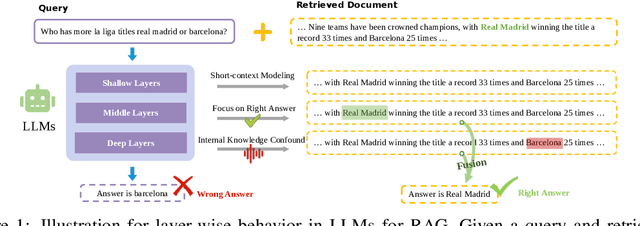
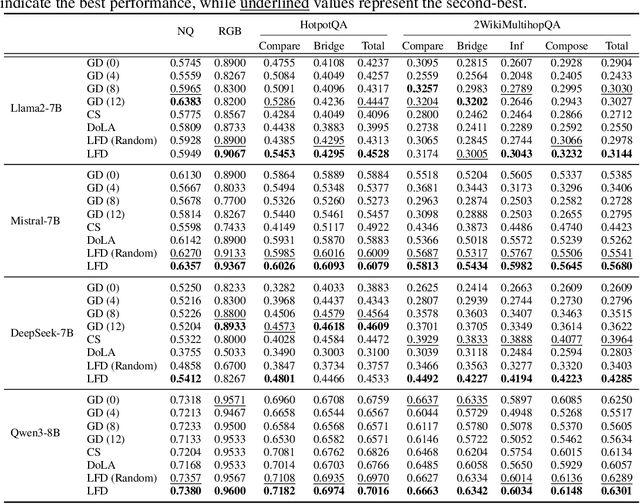
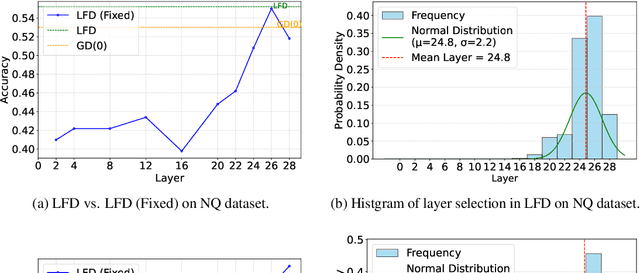
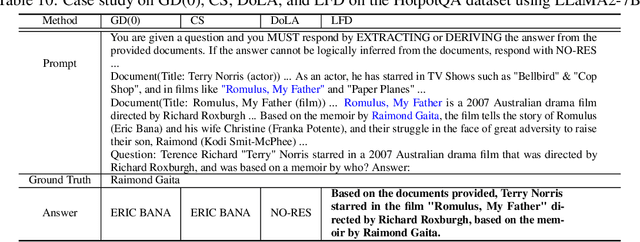
Abstract:Retrieval-augmented generation (RAG) incorporates external knowledge into large language models (LLMs), improving their adaptability to downstream tasks and enabling information updates. Surprisingly, recent empirical evidence demonstrates that injecting noise into retrieved relevant documents paradoxically facilitates exploitation of external knowledge and improves generation quality. Although counterintuitive and challenging to apply in practice, this phenomenon enables granular control and rigorous analysis of how LLMs integrate external knowledge. Therefore, in this paper, we intervene on noise injection and establish a layer-specific functional demarcation within the LLM: shallow layers specialize in local context modeling, intermediate layers focus on integrating long-range external factual knowledge, and deeper layers primarily rely on parametric internal knowledge. Building on this insight, we propose Layer Fused Decoding (LFD), a simple decoding strategy that directly combines representations from an intermediate layer with final-layer decoding outputs to fully exploit the external factual knowledge. To identify the optimal intermediate layer, we introduce an internal knowledge score (IKS) criterion that selects the layer with the lowest IKS value in the latter half of layers. Experimental results across multiple benchmarks demonstrate that LFD helps RAG systems more effectively surface retrieved context knowledge with minimal cost.
Compass-Thinker-7B Technical Report
Aug 12, 2025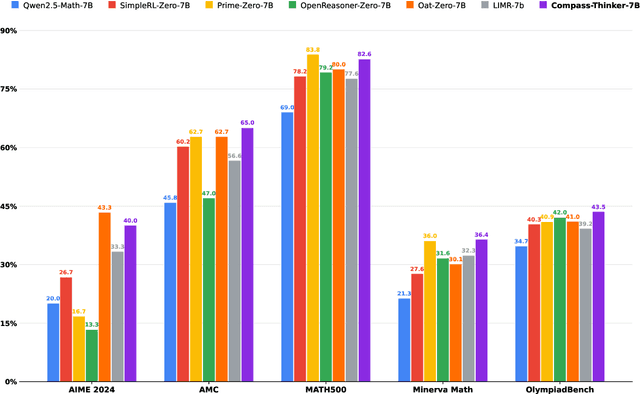

Abstract:Recent R1-Zero-like research further demonstrates that reasoning extension has given large language models (LLMs) unprecedented reasoning capabilities, and Reinforcement Learning is the core technology to elicit its complex reasoning. However, conducting RL experiments directly on hyperscale models involves high computational costs and resource demands, posing significant risks. We propose the Compass-Thinker-7B model, which aims to explore the potential of Reinforcement Learning with less computational resources and costs, and provides insights for further research into RL recipes for larger models. Compass-Thinker-7B is trained from an open source model through a specially designed Reinforcement Learning Pipeline. we curate a dataset of 30k verifiable mathematics problems for the Reinforcement Learning Pipeline. By configuring data and training settings with different difficulty distributions for different stages, the potential of the model is gradually released and the training efficiency is improved. Extensive evaluations show that Compass-Thinker-7B possesses exceptional reasoning potential, and achieves superior performance on mathematics compared to the same-sized RL model.Especially in the challenging AIME2024 evaluation, Compass-Thinker-7B achieves 40% accuracy.
WideSearch: Benchmarking Agentic Broad Info-Seeking
Aug 11, 2025Abstract:From professional research to everyday planning, many tasks are bottlenecked by wide-scale information seeking, which is more repetitive than cognitively complex. With the rapid development of Large Language Models (LLMs), automated search agents powered by LLMs offer a promising solution to liberate humans from this tedious work. However, the capability of these agents to perform such "wide-context" collection reliably and completely remains largely unevaluated due to a lack of suitable benchmarks. To bridge this gap, we introduce WideSearch, a new benchmark engineered to evaluate agent reliability on these large-scale collection tasks. The benchmark features 200 manually curated questions (100 in English, 100 in Chinese) from over 15 diverse domains, grounded in real user queries. Each task requires agents to collect large-scale atomic information, which could be verified one by one objectively, and arrange it into a well-organized output. A rigorous five-stage quality control pipeline ensures the difficulty, completeness, and verifiability of the dataset. We benchmark over 10 state-of-the-art agentic search systems, including single-agent, multi-agent frameworks, and end-to-end commercial systems. Most systems achieve overall success rates near 0\%, with the best performer reaching just 5\%. However, given sufficient time, cross-validation by multiple human testers can achieve a near 100\% success rate. These results demonstrate that present search agents have critical deficiencies in large-scale information seeking, underscoring urgent areas for future research and development in agentic search. Our dataset, evaluation pipeline, and benchmark results have been publicly released at https://widesearch-seed.github.io/
Towards Efficient Partially Relevant Video Retrieval with Active Moment Discovering
Apr 15, 2025



Abstract:Partially relevant video retrieval (PRVR) is a practical yet challenging task in text-to-video retrieval, where videos are untrimmed and contain much background content. The pursuit here is of both effective and efficient solutions to capture the partial correspondence between text queries and untrimmed videos. Existing PRVR methods, which typically focus on modeling multi-scale clip representations, however, suffer from content independence and information redundancy, impairing retrieval performance. To overcome these limitations, we propose a simple yet effective approach with active moment discovering (AMDNet). We are committed to discovering video moments that are semantically consistent with their queries. By using learnable span anchors to capture distinct moments and applying masked multi-moment attention to emphasize salient moments while suppressing redundant backgrounds, we achieve more compact and informative video representations. To further enhance moment modeling, we introduce a moment diversity loss to encourage different moments of distinct regions and a moment relevance loss to promote semantically query-relevant moments, which cooperate with a partially relevant retrieval loss for end-to-end optimization. Extensive experiments on two large-scale video datasets (\ie, TVR and ActivityNet Captions) demonstrate the superiority and efficiency of our AMDNet. In particular, AMDNet is about 15.5 times smaller (\#parameters) while 6.0 points higher (SumR) than the up-to-date method GMMFormer on TVR.
Energy-Efficient Port Selection and Beamforming Design for Integrated Data and Energy Transfer Assisted by Fluid Antennas
Mar 06, 2025Abstract:Integrated data and energy transfer (IDET) is considered as a key enabler of 6G, as it can provide both wireless energy transfer (WET) and wireless data transfer (WDT) services towards low power devices. Thanks to the extra degree of freedom provided by fluid antenna (FA), incorporating FA into IDET systems presents a promising approach to enhance energy efficiency performance. This paper investigates a FA assisted IDET system, where the transmitter is equipped with multiple FAs and transmits wireless signals to the data receiver (DR) and the energy receiver (ER), which are both equipped with a single traditional antenna. The switching delay and energy consumption induced by port selection are taken into account in IDET system for the first time. We aim to obtain the optimal beamforming vector and the port selection strategy at the transmitter, in order to maximize the short-term and long-term WET efficiency, respectively. The instant sub-optimal solution is obtained by alternatively optimizing the beamforming vector and port selection in each transmission frame, while a novel constrained soft actor critic (C-SAC) algorithm is proposed to find the feasible policy of port selection from the long-term perspective. Simulation results demonstrate that our scheme is able to achieve greater gain in terms of both the short-term and long-term WET efficiency compared to other benchmarks, while not degrading WDT performance.
OptMetaOpenFOAM: Large Language Model Driven Chain of Thought for Sensitivity Analysis and Parameter Optimization based on CFD
Mar 03, 2025Abstract:Merging natural language interfaces with computational fluid dynamics (CFD) workflows presents transformative opportunities for both industry and research. In this study, we introduce OptMetaOpenFOAM - a novel framework that bridges MetaOpenFOAM with external analysis and optimization tool libraries through a large language model (LLM)-driven chain-of-thought (COT) methodology. By automating complex CFD tasks via natural language inputs, the framework empowers non-expert users to perform sensitivity analyses and parameter optimizations with markedly improved efficiency. The test dataset comprises 11 distinct CFD analysis or optimization tasks, including a baseline simulation task derived from an OpenFOAM tutorial covering fluid dynamics, combustion, and heat transfer. Results confirm that OptMetaOpenFOAM can accurately interpret user requirements expressed in natural language and effectively invoke external tool libraries alongside MetaOpenFOAM to complete the tasks. Furthermore, validation on a non-OpenFOAM tutorial case - namely, a hydrogen combustion chamber - demonstrates that a mere 200-character natural language input can trigger a sequence of simulation, postprocessing, analysis, and optimization tasks spanning over 2,000 lines of code. These findings underscore the transformative potential of LLM-driven COT methodologies in linking external tool for advanced analysis and optimization, positioning OptMetaOpenFOAM as an effective tool that streamlines CFD simulations and enhances their convenience and efficiency for both industrial and research applications. Code is available at https://github.com/Terry-cyx/MetaOpenFOAM.
Psychometric-Based Evaluation for Theorem Proving with Large Language Models
Feb 02, 2025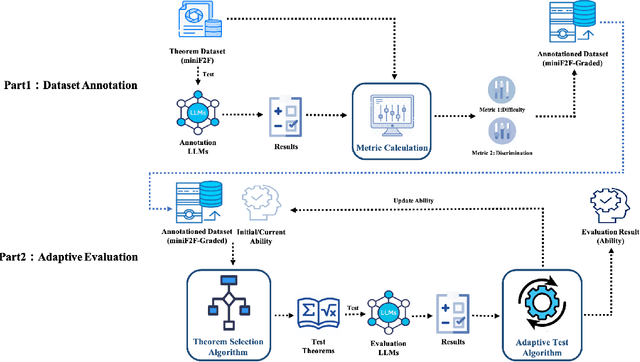

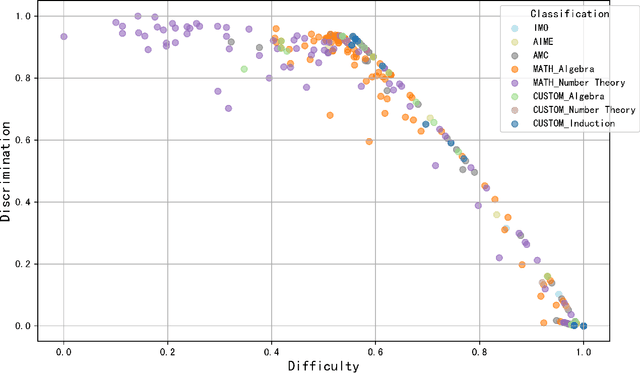

Abstract:Large language models (LLMs) for formal theorem proving have become a prominent research focus. At present, the proving ability of these LLMs is mainly evaluated through proof pass rates on datasets such as miniF2F. However, this evaluation method overlooks the varying importance of theorems. As a result, it fails to highlight the real performance disparities between LLMs and leads to high evaluation costs. This study proposes a psychometric-based evaluation method for theorem proving with LLMs, comprising two main components: Dataset Annotation and Adaptive Evaluation. First, we propose a metric calculation method to annotate the dataset with difficulty and discrimination metrics. Specifically, we annotate each theorem in the miniF2F dataset and grade them into varying difficulty levels according to the performance of LLMs, resulting in an enhanced dataset: miniF2F-Graded. Experimental results show that the difficulty grading in miniF2F-Graded better reflects the theorem difficulty perceived by LLMs. Secondly, we design an adaptive evaluation method to dynamically select the most suitable theorems for testing based on the annotated metrics and the real-time performance of LLMs. We apply this method to evaluate 10 LLMs. The results show that our method finely highlights the performance disparities between LLMs. It also reduces evaluation costs by using only 23% of the theorems in the dataset.
Overview of AI-Debater 2023: The Challenges of Argument Generation Tasks
Jul 24, 2024



Abstract:In this paper we present the results of the AI-Debater 2023 Challenge held by the Chinese Conference on Affect Computing (CCAC 2023), and introduce the related datasets. We organize two tracks to handle the argumentative generation tasks in different scenarios, namely, Counter-Argument Generation (Track 1) and Claim-based Argument Generation (Track 2). Each track is equipped with its distinct dataset and baseline model respectively. In total, 32 competing teams register for the challenge, from which we received 11 successful submissions. In this paper, we will present the results of the challenge and a summary of the systems, highlighting commonalities and innovations among participating systems. Datasets and baseline models of the AI-Debater 2023 Challenge have been already released and can be accessed through the official website of the challenge.
Joint Port Selection and Beamforming Design for Fluid Antenna Assisted Integrated Data and Energy Transfer
Mar 14, 2024



Abstract:Integrated data and energy transfer (IDET) has been of fundamental importance for providing both wireless data transfer (WDT) and wireless energy transfer (WET) services towards low-power devices. Fluid antenna (FA) is capable of exploiting the huge spatial diversity of the wireless channel to enhance the receive signal strength, which is more suitable for the tiny-size low-power devices having the IDET requirements. In this letter, a multiuser FA assisted IDET system is studied and the weighted energy harvesting power at energy receivers (ERs) is maximized by jointly optimizing the port selection and transmit beamforming design under imperfect channel state information (CSI), while the signal-to-interference-plus-noise ratio (SINR) constraint for each data receiver (DR) is satisfied. An efficient algorithm is proposed to obtain the suboptimal solutions for the non-convex problem. Simulation results evaluate the performance of the FA-IDET system, while also demonstrate that FA outperforms the multi-input-multi-output (MIMO) counterpart in terms of the IDET performance, as long as the port number is large enough.
 Add to Chrome
Add to Chrome Add to Firefox
Add to Firefox Add to Edge
Add to Edge